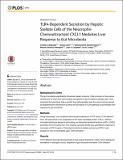TLR4-Dependent Secretion by Hepatic Stellate Cells of the Neutrophil-Chemoattractant CXCL1 Mediates Liver Response to Gut Microbiota
Author(s)
Bigorgne, Amélie E.; John, Beena; Ebrahimkhani, Mohammad Reza; Shimizu-Albergine, Masami; Campbell, Jean S.; Crispe, Ian N.; ... Show more Show less
DownloadBigorgne-2016-TLR4-Dependent Secre.pdf (1.647Mb)
OPEN_ACCESS_POLICY
Open Access Policy
Creative Commons Attribution-Noncommercial-Share Alike
Terms of use
Metadata
Show full item recordAbstract
Background & Aims
The gut microbiota significantly influences hepatic immunity. Little is known on the precise mechanism by which liver cells mediate recognition of gut microbes at steady state. Here we tested the hypothesis that a specific liver cell population was the sensor and we aimed at deciphering the mechanism by which the activation of TLR4 pathway would mediate liver response to gut microbiota.
Methods
Using microarrays, we compared total liver gene expression in WT versus TLR4 deficient mice. We performed in situ localization of the major candidate protein, CXCL1. With an innovative technique based on cell sorting, we harvested enriched fractions of KCs, LSECs and HSCs from the same liver. The cytokine secretion profile was quantified in response to low levels of LPS (1ng/mL). Chemotactic activity of stellate cell-derived CXCL1 was assayed in vitro on neutrophils upon TLR4 activation.
Results
TLR4 deficient liver had reduced levels of one unique chemokine, CXCL1 and subsequent decreased of neutrophil counts. Depletion of gut microbiota mimicked TLR4 deficient phenotype, i.e., decreased neutrophils counts in the liver. All liver cells were responsive to low levels of LPS, but hepatic stellate cells were the major source of chemotactic levels of CXCL1. Neutrophil migration towards secretory hepatic stellate cells required the TLR4 dependent secretion of CXCL1.
Conclusions
Showing the specific activation of TLR4 and the secretion of one major functional chemokine— CXCL1, the homolog of human IL-8-, we elucidate a new mechanism in which Hepatic Stellate Cells play a central role in the recognition of gut microbes by the liver at steady state.
Date issued
2016-03Department
Massachusetts Institute of Technology. Department of Biological EngineeringJournal
PLOS ONE
Publisher
Public Library of Science
Citation
Bigorgne, Amélie E., Beena John, Mohammad R. Ebrahimkhani, Masami Shimizu-Albergine, Jean S. Campbell, and Ian N. Crispe. “TLR4-Dependent Secretion by Hepatic Stellate Cells of the Neutrophil-Chemoattractant CXCL1 Mediates Liver Response to Gut Microbiota.” Edited by Michel Samson. PLoS ONE 11, no. 3 (March 22, 2016): e0151063.
Version: Final published version
ISSN
1932-6203